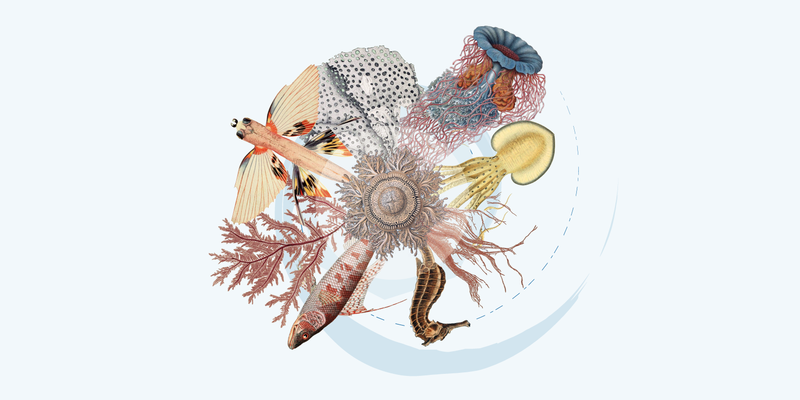News
Updated guide adds details on how to publish DNA-derived data on marine life
Published 6/7/2023

An expert team of authors has updated Publishing DNA-derived data through biodiversity data platforms, a practical guide for holders of genomic and metagenomic information, to include recommendations for sharing occurrence records based on DNA-based studies of the world's oceans and seas.
The guide, first published in September 2021, reinforces expectations that primary genomic data is first shared through one of the three mirrors comprising the International Nucleotide Sequence Database Collaboration (INSDC). But by resurfacing DNA-derived evidence on non-human organisms as occurrence records on biodiversity platforms like those maintained by GBIF and Ocean Biodiversity Information System (OBIS), data holders contribute to a more complete and cross-indexed view of world's biodiversity.
The guide's new marine-focused section offers recommendations for optimizing environmental DNA (eDNA) data shared with OBIS, which (like GBIF) relies on the Darwin Core standard and the GBIF Integrated Publishing toolkit (IPT). As an integral component of the International Oceanographic Data and Information Exchange (IODE) programme of the Intergovernmental Oceanographic Commission (IOC) of UNESCO, OBIS.org provides a global platform specializing in data and information on the diversity, distribution and abundance of marine life.
With its presence within the UN system and its exclusive focus on oceans, the OBIS network applies rigourous quality controls that lead to small but critical differences in how the same data are represented on OBIS.org and GBIF.org, ensuring the reliable application of OBIS-mediated data in support of UN processes and its Member states.
Holders of genomic and metagenomic data on biodiversity can achieve the broadest audience and impact from their efforts by publishing marine datasets optimized for use through OBIS, GBIF and other biodiversity databases. Following the new OBIS-specific advice in the guide will ensure:
- consistent alignment with the taxonomic nomenclature in the World Register of Marine Species (WoRMS)
- accuracy of location and depth coordinates
- inclusion of additional measurements and facts describing key attributes related to biological occurrences
"We are witnessing a boom of new data being published into OBIS through the revolutionary technology of eDNA," said Ward Appeltans, coordinator of OBIS at UNESCO. "Citizen-science eDNA expeditions like those organized by UNESCO are paving the way for a transformation in the way we will do biodiversity monitoring in the future. Having clear guidelines on how to publish these data in open repositories like OBIS and GBIF is crucial and very timely."
"The widespread use of molecular data to detect, describe, classify and quantify taxa in molecular ecology, phylogenetics and other areas of biodiversity research provides us with a more holistic digital picture of nature," said Tobias Guldberg Frøslev, programme officer for science support at the GBIF Secretariat. "We hope the updated guide and our efforts to make it easier for holders of such data contribute to wider applications in research and policy related to biodiversity."
Reporting DNA-derived occurrences on biodiversity platforms that support FAIR and open data can offer data holders several benefits, among them:
- The application of taxonomic and ecological knowledge to conservation, climate change, ecology, human health and other life-science disciplines
- Improved knowledge discovery for organisms that are often undersampled and overlooked, enabling their greater integration into conservation and policymaking applications
- A dynamic mechanism for making occurrence records of undescribed taxa available and ready to update once they are described
- Increased citability and reuse of data
The updated guide reflects just one strand of ongoing GBIF activities around DNA.
- Case studies on DNA-derived data will provide the topic for the next online workshop as we explore a diversified data model on Thursday, 8 June 2023, at 13:00 UTC. Register to join the webinar (or look for the recording, icymi).
- In response to a community survey earlier this year, the GBIF Secretariat is looking for volunteers willing to share processed eDNA metabarcoding datasets to help us test and refine an experimental data-publishing tool and develop guidelines for its use. Get the details in this post on the GBIF community forum.
Authors
- Kessy Abarenkov, University of Tartu Natural History Museum and Botanical Garden, Estonia
- Anders F. Andersson, KTH Royal Institute of Technology, Sweden
- Andrew Bissett, CSIRO, Australia
- Anders G. Finstad, Norwegian University of Science and Technology, Norway
- Frode Fossøy, Norwegian Institute for Nature Research (NINA), Norway
- Marie Grosjean, GBIF Secretariat, Denmark
- Michael Hope, Atlas of Living Australia & CSIRO National Collections & Marine Infrastructure, Australia
- Thomas S. Jeppesen, GBIF Secretariat, Denmark
- Urmas Kõljalg, Natural History Museum and Botanical Garden, University of Tartu, Estonia
- Daniel Lundin, Linnaeus University, Sweden
- R. Henrik Nilsson, University of Gothenburg, Sweden
- Maria Prager, Stockholm University & Karolinska Institutet, Sweden
- Pieter Provoost, Ocean Biodiversity Information System, Belgium
- Dmitry Schigel, GBIF Secretariat, Denmark
- Saara Suominen, Ocean Biodiversity Information System, Belgium
- Cecilie Svenningsen, GBIF Secretariat, Denmark
- Tobias Guldberg Frøslev, GBIF Secretariat, Denmark